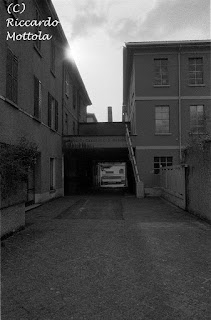From old Exakta lenses to Nikkor AF Zooms, apparently anyone gets there.
This time, the classic Minolta 50/1.7 has the issue, although in its AF version.
Dismounting AF lenses can be tricky, but in here everything seems fine, except the Iris. I want to avoid regreasing the helicoids because I haven't yet found a satisfactory Grease, even if I tried several! I will try unmounting as little as possible from the lens as possible to get to the Diaphgram Iris assembly.
We can work from the front, by unscrewing in sequence the cone with the name plate first, then removing 3 screws to remove the the front part with the retractable sun shade. Without these parts, the lens is still fully functional.
From the rear, we can remove the lens bayonet and put it aside and we see the picture like this:
 |
| AF Rokkor 50/1.7 from the back, mount removed (left) |
The optical assembly is in the middle and has two guides, clearly seen top and bottom in this picture. Mark the helicoid for convenience and unscrew them
Now it is possible to unscrew the optical kernel to the back of the lens.
Getting it back will be a little tricky, since the infinite setting needs to remain. Even if I marked the helicoid, I needed a couple of attempts.
The hard part is done! The 50mm is a double-gauss type and it is easy to take it apart. Removing three screws enables to remove the front part and the same is for the back.
What remains is just the Aluminum barrel with the Iris mechanism inside. Now you can clean it by flushing or by opening it.
My first attempt of repair was done with a flush-clean: often this is enough if just a little oil is astray. However it worked for a couple of months, but then the blades stuck again. This means there was a lot of oil in the non-accessible mechanism (the ring that acts as governor for every pin), so a more drastic solution was needed: remove the blades with their governor ring.
 |
| The open diaphgram blades, the governor on top |
Mounting everything back is relatively easily, except for getting the right screw thread and not damaging the delicate Aluminum thread when screwing it in.
Check the infinity focus.. and that the diaphgram is snappy again!





